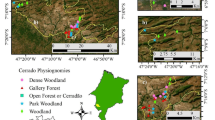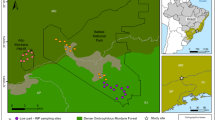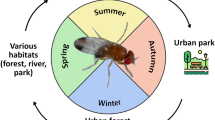Abstract
Two methods were compared for capturing the bark beetle Ips duplicatus Sahlberg (Coleoptera: Curculionidae, Scolytinae): lure-baited, insecticide-treated tripod trap logs (TRIPODs) versus Theysohn pheromone traps (TPTs). In 2008 and 2011 and at each of three clearcuts, five TPTs and five TRIPODs baited with ID Ecolure pheromone evaporators were installed with 10 m spacing. The pheromone evaporators were renewed every 8 weeks. The TRIPODs were treated with the insecticide Vaztak 10 EC in mid-April and then every 5 weeks thereafter. Trap logs and traps were inspected weekly during the entire period of I. duplicatus flight activity (April–September). Two to three times more beetles were trapped by the TPTs than by the TRIPODs. The TPTs captured more females than males, while TRIPODs captured equivalent numbers of males and females or more males than females on some dates. The TPTs and TRIPODs trapped approximately the same numbers of males, but the TPTs captured more females than the TRIPODs. Both traps captured more adults in spring than in summer. The higher numbers of entomophagous arthropods, including the predacious beetles Thanasimus formicarius L. and T. femoralis, were captured in the TRIPODs than in the TPTs.




Similar content being viewed by others
References
Abgrall JF (1987) L’utilisation de la methode des arbres-pitges avec les pheromones de synthese dam la lutte contre le typographe. CEMAGREF Inf Tech 67(1):l–4
Adlung KG, Schicke P, O’svath J (1986) Analyse einer Untersuchung zur Bekämpfung des Buchdruckers (Ips typographus L.) unter Einsatz von Pheromonen. J Plant Dis Prot 93(5):462–478; 93(6):574–584
Bakke A, Kvamme T (1981) Kairomone response in Thanasimus predators to pheromone components of Ips typographus. J Chem Ecol 7:305–312
Bombosch S (1988) Some considerations on the use of bark beetles pheromones. In: Payne TL, Saarenmaa H (eds) Integrated control of scolytid bark beetles. Vancouver Virginia Polytechnic Institute and State University Press, Blacksburg, pp 263–265
Byers JA (1983) Sex-specific responses to aggregation pheromone: regulation of colonization density in the bark beetle Ips paraconfusus. J Chem Ecol 9:129–142
Croft BA (1990) Arthropod biological control agents and pesticides. Wiley, New York, p 723
Desneux N, Decourtye A, Delpuech J-M (2007) The sublethal effects of pesticides on beneficial arthropods. Annu Rev Entomol 52:81–106
Drumont A, Gonzalez R, de Windt N, Grégoire J-C, de Proft M, Seutin E (1992) Semiochemicals and the integrated management of Ips typographus (L.) (Col., Scolytidae) in Belgium. J Appl Entomol 114:333–337
Grodzki W (1997) Możliwości kontroli liczebności populacji kornika zrosłozębnego Ips duplicatus C.R. Sahlb. na południu Polski. Sylwan 11:25–36
Grodzki W (2003) Zasięg występowania kornika zrosłozębnego Ips duplicatus C.R. Sahlb. (Col.: scolytidae) w obszarach górskich południowej Polski. Sylwan 8:29–36
Haynes KF (1988) Sublethal effects of neurotoxic insecticides on insect behavior. Annu Rev Entomol 33:149–168
Holuša J, Lubojacký J, Knížek M (2010a) Distribution of double-spined spruce bark beetle Ips duplicatus in the Czech Republic: spreading in 1997–2009. Phytoparasitica 38:435–443
Holuša J, Grodzki W, Lukášová K (2010b) Porównanie skuteczności dyspenserów feromonowych ID Ecolure, Pheagr IDU i Duplodor na kornika zrosłozębnego (Ips duplicatus). Sylwan 154:363–370
Hulcr J, Ubik K, Vrkoč J (2006) The role of semiochemicals in tritrophic interactions between the spruce bark beetle Ips typographus, its predators and infested spruce. J Appl Entomol 130:275–283
Hurling R, Stetter J (2012) Untersuchungen zur fangleistung von schlitzfallen und fangholzhaufen bei der lokalen dichteabsenkung von buchdrucker (Ips typographus)-populationen. Gesunde Pflanzen 64:89–99. doi:10.1007/s10343-012-0277-y
Jakuš R, Blaženec M (2002) Influence of proportion of (4S)-cisverbenol in pheromone bait on Ips typographus (Col., Scolytidae) catch in pheromone trap barrier and in single traps. J Appl Entomol 126:306–311
Jeniš J, Vrba M (2007) Srovnání účinnosti lapáků, otrávených trojnožek a lapačů. Lesn práce 86:586
Knížek M (1998) Rozšíření lýkožrouta severského Ips duplicatus (Sahlberg) v České republice a možnosti obranných opatření. In: Biotičtí škodliví činitelé v lesích ČR. VÚLHM Jíloviště-Strnady, Prague, Czech Republic, pp 45–50
Knížek M (2005) ČSN 48 1000. Český normalizační institut, Prague, Czech Republic, Ochrana lesa proti kůrovcům na smrku
Knížek M, Holuša J (2007) Lýkožrout severský. Ips duplicatus Sahlberg. 2nd ed. Lesn práce 86(4) (Příloha):I–IV
Knížek M, Zahradník P (1996) Mass outbreak of Ips duplicatus Sahlberg (Coleoptera, Scolytidae). In: Doe J (ed) XX International congress of entomology, August 25–31 1996. Firenze, Italy, p 527
Koleva P, Kolev N, Schopf A, Wegensteiner R (2012) Untersuchungen zur Effizienz von insektizidbehandelten Fanghölzern gegen den Buchdrucker Ips typographus (Coleoptera, Curculionidae). Forstschutz Aktuell 54:16–21
Lubojacký J, Holuša J (2011) Comparison of spruce bark beetle (Ips typographus) catches between treated trap logs and pheromone traps. Šumar list 85:233–242
Okland B, Bakke A, Hagvar S, Kvamme T (1996) What factors influence the diversity of saproxylic beetles? A multiscaled study from a spruce forest in southern Norway. Biodiv Conserv 5:75–100
Pfeffer A (1989) Kůrovcovití scolytizdae a jádrohlodovití platypodidae. Academia, Prague
Schlyter F, Zhang QH, Liu GT, Ji LZ (2001) A successful case of pheromone mass trapping of the bark beetle Ips duplicatus in a forest island, analysed by 20-year time-series data. Integr Pest Manag Rev 6:185–196
Schnaider Z, Sierpiński Z (1955) Z biologii kornika zrosłozębnego (Ips duplicatus Sahlb.). Roczn Nauk Leśn 13:59–68
Schroeder LM (2003) Differences in responses to α-pinene and ethanol, and flight periods between the bark beetle predators Thanasimus femoralis and T. formicarius (Col.: Cleridae). For Ecol Manag 177:301–311
Smith IM, McNamara DG, Scott PR, Holderness M (1996) Quarantine pests for Europe, 2nd edn. CAB International, Wallingford
Tomiczek C (2009) Fangtipi und pheromonfalle: erste ergebnisse einer vergleichsuntersuchung zu fangleistung und naturschutzaspekten. Forstschutz Aktuell 48:6–7
Vakula J, Brutovský D, Gubka A, Galko J, Kunca A (2009) Vyhodnotenie monitoringu lykožrúta severského Ips duplicatus Sahlb. v roku 2009 v Lesoch SR, š. p. a niektorých neštátnych subjektoch. NLC–LVÚ, Zvolen, Slovakia
Vité JP (1989) The European struggle to control Ips typographus: past, present and future. Hol Ecol 12:520–525
Vrba M (2009) Ohrožení smrkových porostů kambiofágy u VLS Lipník nad Bečvou a ekonomické aspekty užití lapáků v ochraně lesa. MS Thesis, Mendel University of Agriculture and Forestry, Brno
Wermelinger B (2004) Ecology and management of the spruce bark beetle Ips typographus—a review of recent research. For Ecol Manag 202:67–82
Werner RA, Hastings FL, Averill R (1983) Laboratory and field evaluation of insecticides against the spruce bark beetle (Coleoptera, Scolytidae) and parasites and predators in Alaska. J Econ Entomol 76:1144–1147
Zahradník P (2004) Ochrana smrčin proti kůrovcům. Lesnická práce nad Černými lesy, Kostelec
Zahradník P (2005) Základy ochrany lesa v praxi. VÚLHM Jíloviště-Strnady, Prague
Zhang QH, Schlyter F (1995) Distribution, mortality and sex-ratio of overwintering Ips duplicatus (Coleoptera, Scolytidae) in the soil of Picea koraiensis reserve in Inner Mongolia, China, with a model of diffusion. In: Hain FP, Salom S, Ravlin W, Payne TL, Raffa KF (eds) Behavior, population dynamics and control of forest insects. Ohio State University, Columbus
Zhang QH, Liu GT, Schlyter F, Birgersson G, Anderson P, Valeur P (2001) Olfactory responses of Ips duplicatus from inner Mongolia, China to nonhost leaf and bark volatiles. J Chem Ecol 27:995–1010
Acknowledgments
The authors wish to thank Dr. Bruce Jaffee (USA) for linguistic and editorial improvements and J. Slavíček, M. Gracl, J. Lubojacký, and J. Lubojacký Jr. for practical suggestions and technical assistance in the field studies. The research was supported by the Grant IGA 43150/1312/3133, Verifying the effectiveness of poisoned traps used against Ips duplicatus Sahl., from the Czech University of Life Sciences Prague and partly by Grant No. QH 81136 from the Ministry of Agriculture of the Czech Republic.
Author information
Authors and Affiliations
Corresponding author
Additional information
Communicated by A. Battisti.
Rights and permissions
About this article
Cite this article
Lubojacký, J., Holuša, J. Comparison of lure-baited insecticide-treated tripod trap logs and lure-baited traps for control of Ips duplicatus (Coleoptera: Curculionidae). J Pest Sci 86, 483–489 (2013). https://doi.org/10.1007/s10340-013-0492-z
Received:
Accepted:
Published:
Issue Date:
DOI: https://doi.org/10.1007/s10340-013-0492-z




